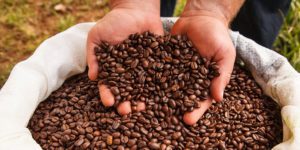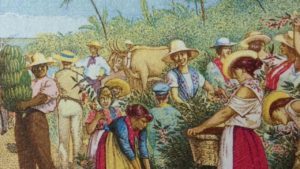Our delicious coffee has been a beautiful culture for many years. Also, it has been, for almost 2 centuries, the main source of family income and national divisions. The first coffee seeds came from the Caribbean Antilles, between 1776 and October 12th, 1820.
The first person who cultivated coffee grains was Father Feliz Velarde, in 1816. In his will, he left written that he had planted coffee on his land, and gave all his neighbors seeds to encourage them to sow this aromatic product.
The first 2 Heads of State of that time helped the flourishing coffee industry to achieve great progress. Actually, they considered coffee as a product capable of generating economic growth, which would benefit all Costa Ricans, and coffee production itself, in the following years.
In 1832, coffee started to be commercialized. The first export went to Chile. There, people who bought it were European, who re-exported it to London. Its name was Chilean Coffee of Valparaíso.
Pure quality
Our coffee is 100% belonging to the Arabica species “Caturra” and “Catuaí”, which produce a grain with higher quality, pleasant, with a good aroma, and very good flavor.

In Costa Rica, coffee is grown in fertile soils, which are of volcanic origin and low acidity. These are the best conditions for the place where coffee is expected to be grown.
Most of the coffee area -approximately 80%- is located between 800 and 1,600 meters high, and its temperatures are between 17 C° and 28 C°, with annual rainfall of between 2,000 and 2,000 millimeters.
Nowadays, thanks to the great available technology, plantations have been able to adapt themselves to the areas where they will be grown.
In 2001, the coffee institute of our country, Icafé, gave birth to a “National Coffee Plan” where everything the institute did helped improve production and marketing.
In our country, coffee is grown in 8 producing areas. They are the Brunca Region, Turrialba, Tres Ríos, Orosí, Tarrazú, Central and Western Valleys, and Guanacaste.
An interesting fact with regard to coffee is that only ripe grain is chosen. The pulp removal takes place on the same day that the grain is harvested. Before their fermentation, they are sorted and cleaned, in order to eliminate pulp that is left over and to remove the defecting grains.

Most of the coffee plantations in Costa Rica are organized with interspersed shade. Through this pattern, some positive impacts such as the decomposition of the leaves that returns a large amount of organic matter to the soil are obtained. Similarly, the cultivation of pending high plantations contributes to prevent erosion.
In order to guarantee the product that reaches the person who will consume it, coffee must be certified. That is why the “Sustainable Coffee Seal” was created.
What a delicious coffee!
In our country, coffee is grown entirely by hand and, as time goes by, its quality has improved. This fabulous process has been able to develop a very particular culture, with rituals and traditions for more than 2 centuries. In this sense, both Colombia and Costa Rica are the producers of the best coffee in the world.
Colombia, since 1959, has been investing in this industry many US$ millions every year. Its image is of a fictional character named “Juan Valdéz”, which was originated by the US advertising agency Doyle Dane Berncach, has become famous worldwide. Its brand character, Juan Valdéz, has a mule called “Conchita”, and he is always accompanied by the mountains of the Colombian Andes, in the background.
On July 7th, 2006, the Colombian Coffee Federation (Fedecafé) sustained a demand of 1 US$ million against Café Britt; this is an international company, well-known for marketing coffee in our country. All this because they started selling shirts that showed this coffee logo.
Its picks in carts

While the coffee harvest was taking place, pickings were also taken. Most Costa Ricans were raised and studied on the coffee plants. Out of all this process, on which we are taught since the youngest age, a new way of seeing life has been born. That is how we can understand human relationships of most of our people.
Everyday conversations that took place in the coffee plantation were always very important; they talked about religion, politics, sports, history, gossip, chilis, songs, broken hearts, among many other subjects.
There were many legends around plantations; they even include leprechauns (kind of magical fairy-beings from the Irish folklore) and the weeping woman, whom local people think is always looking for a supposed missing child of hers.
![]()
